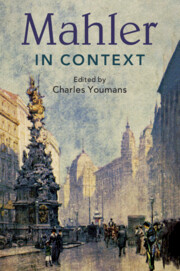Book contents
- Mahler in Context
- Composers in Context
- Mahler in Context
- Copyright page
- Dedication
- Contents
- Figures
- Music Examples
- Notes on Contributors
- Preface and Acknowledgments
- Abbreviations
- Part I Formation
- Part II Performance
- Part III Creation
- Chapter 12 The Composer “Goes to Press”
- Chapter 13 Mahler and Program Music
- Chapter 14 Intertextuality in Mahler
- Chapter 15 The Symphony, 1870–1911
- Chapter 16 Mahler and the Visual Arts of His Time
- Chapter 17 Mahler and Modernism
- Chapter 18 Reception in Vienna
- Chapter 19 Mahler’s Press from London to Los Angeles
- Part IV Mind, Body, Spirit
- Part V Influence
- Further Reading
- Index
Chapter 15 - The Symphony, 1870–1911
from Part III - Creation
Published online by Cambridge University Press: 18 December 2020
- Mahler in Context
- Composers in Context
- Mahler in Context
- Copyright page
- Dedication
- Contents
- Figures
- Music Examples
- Notes on Contributors
- Preface and Acknowledgments
- Abbreviations
- Part I Formation
- Part II Performance
- Part III Creation
- Chapter 12 The Composer “Goes to Press”
- Chapter 13 Mahler and Program Music
- Chapter 14 Intertextuality in Mahler
- Chapter 15 The Symphony, 1870–1911
- Chapter 16 Mahler and the Visual Arts of His Time
- Chapter 17 Mahler and Modernism
- Chapter 18 Reception in Vienna
- Chapter 19 Mahler’s Press from London to Los Angeles
- Part IV Mind, Body, Spirit
- Part V Influence
- Further Reading
- Index
Summary
Notwithstanding their remarkable peculiarities and profoundly individual nature, Mahler’s symphonies were part of a tradition begun by Haydn, Mozart, and Beethoven; extended by Mendelssohn, Schumann, and Berlioz; and renewed during his lifetime by composers including Bruckner, Brahms, Bruch, Borodin, Tchaikovsky, Dvořák, Franck, Saint-Saëns, Elgar, Strauss, Sibelius, Nielsen, and Glazunov. This context is surveyed here in two periods: composers who flourished during Mahler’s youth roughly (1870–89) and those active from 1889 until the outbreak of World War I. The former period reveals that even within this relatively conservative choice of genre (vis-à-vis the symphonic poem) a remarkable of approach obtained, from the motivic integration of Brahms and the fragmented grandeur of Bruckner to the lyricism and user-friendly national influences of Dvořák and Tchaikovsky. In the later group, a trend toward amalgamation of programmatic and traditionally symphonic impulses becomes more pronounced, such as one finds in Mahler’s own works.
- Type
- Chapter
- Information
- Mahler in Context , pp. 127 - 135Publisher: Cambridge University PressPrint publication year: 2020

